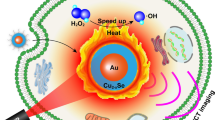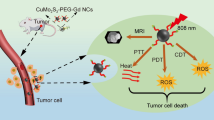Abstract
The doping of radiocontrast agent such as bismuth (Bi) in copper chalcogenide nanocrystals for computed tomography (CT) imaging guided photothermal therapy (PTT) has drawn increasing attention. However, the doping of Bi often suffers from the weak CT signal due to the low Bi doping concentration and deteriorates the PTT efficacy of copper chalcogenides. Here we report a multifunctional nanoprobe by encapsulating both Cu1.94S and Bi2S3 nanocrystals into a biocompatible poly(amino acid) matrix with size of ~85 nm for CT imaging guided PTT. The amount of nanocrystals and the ratio of Cu1.94S-to-Bi2S3 in the multifunctional nanocomposites (NCs) are tunable toward both high photothermal conversion efficiency (~31%) and excellent CT imaging capability (27.8 HU g L−1). These NCs demonstrate excellent effects for photothermal ablation of tumors after intratumoral injection on 4T1 tumor-bearing mice. Our study may provide a facile strategy for the fabrication of multi-functional theranostics towards simultaneous strong CT signal and excellent PTT.
摘要
铋掺杂硫化铜纳米晶用于CT成像指导的光热治疗已经引起了人们的广泛关注. 然而, 低剂量的铋掺杂CT信号弱, 高剂量铋掺杂又会减弱硫化铜的光热效果. 本文报道了一种多功能纳米探针, 用两亲性高分子将油溶性Cu1.94S和Bi2S3纳米晶同时封装于约85 nm大小的纳米微球中,用于CT成像指导光热治疗. 多功能纳米探针中Cu1.94S和Bi2S3纳米晶的量和比例能够灵活调节, 从而得到较高的光热转换效率(~31%)和良好的CT成像能力(27.8 HU g L−1). 这些纳米探针在4T1荷瘤小鼠进行瘤内注射后, 显示了良好的CT成像与肿瘤光热治疗效果. 该复合纳米探针的制备方法还可用于其他多功能纳米探针的制备.
Similar content being viewed by others
References
Sugiura T, Matsuki D, Okajima J, et al. Photothermal therapy of tumors in lymph nodes using gold nanorods and near-infrared laser light with controlled surface cooling. Nano Res, 2015, 8: 3842–3852
Song X, Chen Q, Liu Z. Recent advances in the development of organic photothermal nano-agents. Nano Res, 2015, 8: 340–354
Yang Z, Ding X, Jiang J. Facile synthesis of magnetic-plasmonic nanocomposites as T 1 MRI contrast enhancing and photothermal therapeutic agents. Nano Res, 2016, 9: 787–799
Xu S, Cui J, Wang L. Recent developments of low-toxicity NIR II quantum dots for sensing and bioimaging. TrAC Trends Anal Chem, 2016, 80: 149–155
Huang S, Yan W, Hu G, et al. Facile and green synthesis of biocompatible and bioconjugatable magnetite nanofluids for highresolutionT2 MRI contrast agents. J Phys Chem C, 2012, 116: 20558–20563
Zhang R, Zhao J, Han G, et al. Real-time discrimination and versatile profiling of spontaneous reactive oxygen species in living organisms with a single fluorescent probe. J Am Chem Soc, 2016, 138: 3769–3778
Mei Q, Zhang Z. Photoluminescent graphene oxide ink to print sensors onto microporous membranes for versatile visualization bioassays. Angew Chem Int Ed, 2012, 51: 5602–5606
Liu R, Liu B, Guan G, et al. Multilayered shell SERS nanotags with a highly uniform single-particle Raman readout for ultrasensitive immunoassays. Chem Commun, 2012, 48: 9421–9423
Zhang K, Zhou H, Mei Q, et al. Instant visual detection of trinitrotoluene particulates on various surfaces by ratiometric fluorescence of dual-emission quantum dots hybrid. J Am Chem Soc, 2011, 133: 8424–8427
Lusic H, Grinstaff MW. X-ray-computed tomography contrast agents. Chem Rev, 2013, 113: 1641–1666
Badea CT, Drangova M, Holdsworth DW, et al. In vivo smallanimal imaging using micro-CT and digital subtraction angiography. Phys Med Biol, 2008, 53: R319–R350
Cheng L, Liu J, Gu X, et al. PEGylated WS2 nanosheets as a multifunctional theranostic agent for in vivo dual-modal CT/photoacoustic imaging guided photothermal therapy. Adv Mater, 2014, 26: 1886–1893
Ai K, Liu Y, Liu J, et al. Large-scale synthesis of Bi2S3 nanodots as a contrast agent for in vivo X-ray computed tomography imaging. Adv Mater, 2011, 23: 4886–4891
Haller C, Hizoh I. The cytotoxicity of iodinated radiocontrast agents on renal cells in vitro. Invest Radiol, 2004, 39: 149–154
Leeuwenburgh MMN, Wiarda BM, Wiezer MJ, et al. Comparison of imaging strategies with conditional contrast-enhanced CT and unenhanced MR imaging in patients suspected of having appendicitis: a multicenter diagnostic performance study. Radiology, 2013, 268: 135–143
Liu Y, Ai K, Lu L. Nanoparticulate X-ray computed tomography contrast agents: from design validation to in vivo applications. Acc Chem Res, 2012, 45: 1817–1827
Lee N, Cho HR, Oh MH, et al. Multifunctional Fe3O4/TaOx core/ shell nanoparticles for simultaneous magnetic resonance imaging and X-ray computed tomography. J Am Chem Soc, 2012, 134: 10309–10312
Fang Y, Peng C, Guo R, et al. Dendrimer-stabilized bismuth sulfide nanoparticles: synthesis, characterization, and potential computed tomography imaging applications. Analyst, 2013, 138: 3172
Liu J, Zheng X, Yan L, et al. Bismuth sulfide nanorods as a precision nanomedicine for in vivo multimodal imaging-guided photothermal therapy of tumor. ACS Nano, 2015, 9: 696–707
Zhang XD, Chen J, Min Y, et al. Metabolizable Bi2Se3 nanoplates: biodistribution, toxicity, and uses for cancer radiation therapy and imaging. Adv Funct Mater, 2014, 24: 1718–1729
Elsabahy M, Heo GS, Lim SM, et al. Polymeric nanostructures for imaging and therapy. Chem Rev, 2015, 115: 10967–11011
Rabin O, Manuel Perez J, Grimm J, et al. An X-ray computed tomography imaging agent based on long-circulating bismuth sulphide nanoparticles. Nat Mater, 2006, 5: 118–122
Huang P, Bao L, Zhang C, et al. Folic acid-conjugated silicamodified gold nanorods for X-ray/CT imaging-guided dual-mode radiation and photo-thermal therapy. Biomaterials, 2011, 32: 9796–9809
Liu Y, Miyoshi H, Nakamura M. Nanomedicine for drug delivery and imaging: a promising avenue for cancer therapy and diagnosis using targeted functional nanoparticles. Int J Cancer, 2007, 120: 2527–2537
Xiao Q, Zheng X, Bu W, et al. A core/satellite multifunctional nanotheranostic for in vivo imaging and tumor eradication by radiation/photothermal synergistic therapy. J Am Chem Soc, 2013, 135: 13041–13048
Cheng L, Yang K, Li Y, et al. Facile preparation of multifunctional upconversion nanoprobes for multimodal imaging and dual-targeted photothermal therapy. Angew Chem, 2011, 123: 7523–7528
Cui J, Jiang R, Xu S, et al. Cu7S4 nanosuperlattices with greatly enhanced photothermal efficiency. Small, 2015, 11: 4183–4190
Huang S, Liu J, He Q, et al. Smart Cu1.75S nanocapsules with high and stable photothermal efficiency for NIR photo-triggered drug release. Nano Res, 2015, 8: 4038–4047
Li Y, Lu W, Huang Q, et al. Copper sulfide nanoparticles for photothermal ablation of tumor cells. Nanomedicine, 2010, 5: 1161–1171
Xiao Z. CuS nanoparticles: clinically favorable materials for photothermal applications? Nanomedicine, 2014, 9: 373–375
Tian Q, Jiang F, Zou R, et al. Hydrophilic Cu9S5 nanocrystals: a photothermal agent with a 25.7% heat conversion efficiency for photothermal ablation of cancer cells in vivo. ACS Nano, 2011, 5: 9761–9771
Mou J, Chen Y, Ma M, et al. Facile synthesis of liposome/Cu2−x S-based nanocomposite for multimodal imaging and photothermal therapy. Sci China Mater, 2015, 58: 294–301
Chen H, Song M, Tang J, et al. Ultrahigh 19F loaded Cu1.75S nanoprobes for simultaneous 19F magnetic resonance imaging and photothermal therapy. ACS Nano, 2016, 10: 1355–1362
Hu G, Tang J, Bai X, et al. Superfluorinated copper sulfide nanoprobes for simultaneous 19F magnetic resonance imaging and photothermal ablation. Nano Res, 2016, 9: 1630–1638
Jia GZ, Lou WK, Cheng F, et al. Excellent photothermal conversion of core/shell CdSe/Bi2Se3 quantum dots. Nano Res, 2015, 8: 1443–1453
Yi X, Yang K, Liang C, et al. Imaging-guided combined photothermal and radiotherapy to treat subcutaneous and metastatic tumors using iodine-131-doped copper sulfide nanoparticles. Adv Funct Mater, 2015, 25: 4689–4699
Xi G, Ouyang S, Li P, et al. Ultrathin W18O49 nanowires with diameters below 1 nm: synthesis, near-infrared absorption, photoluminescence, and photochemical reduction of carbon dioxide. Angew Chem Int Ed, 2012, 51: 2395–2399
Tian Q, Hu J, Zhu Y, et al. Sub-10 nm Fe3O4@Cu2–x S core-shell nanoparticles for dual-modal imaging and photothermal therapy. J Am Chem Soc, 2013, 135: 8571–8577
Zha Z, Yue X, Ren Q, et al. Uniform polypyrrole nanoparticles with high photothermal conversion efficiency for photothermal ablation of cancer cells. Adv Mater, 2013, 25: 777–782
Liu J, Wang P, Zhang X, et al. Rapid degradation and high renal clearance of Cu3BiS3 nanodots for efficient cancer diagnosis and photothermal therapy in vivo. ACS Nano, 2016, 10: 4587–4598
Li J, Zhong H, Liu H, et al. One dimensional ternary Cu-Bi-S based semiconductor nanowires: synthesis, optical and electrical properties. J Mater Chem, 2012, 22: 17813–17819
Li H, Zhang Q, Pan A, et al. Single-crystalline Cu4Bi4S9 nanoribbons: facile synthesis, growth mechanism, and surface photovoltaic properties. Chem Mater, 2011, 23: 1299–1305
Temple DJ, Kehoe AB, Allen JP, et al. Geometry, electronic structure, and bonding in CuMCh2 (M = Sb, Bi; Ch = S, Se): alternative solar cell absorber materials? J Phys Chem C, 2012, 116: 7334–7340
Huang S, Bai M, Wang L. General and facile surface functionalization of hydrophobic nanocrystals with poly(amino acid) for cell luminescence imaging. Sci Rep, 2013, 3: 2023–2026
Deng M, Tu N, Bai F, et al. Surface functionalization of hydrophobic nanocrystals with one particle per micelle for bioapplications. Chem Mater, 2012, 24: 2592–2597
Roper DK, Ahn W, Hoepfner M. Microscale heat transfer transduced by surface plasmon resonant gold nanoparticles. J Phys Chem C, 2007, 111: 3636–3641
Huang S, Peng S, Li Y, et al. Development of NIR-II fluorescence image-guided and pH-responsive nanocapsules for cocktail drug delivery. Nano Res, 2015, 8: 1932–1943
Kang HS, Yang SR, Kim JD, et al. Effects of grafted alkyl groups on aggregation behavior of amphiphilic poly(aspartic acid). Langmuir, 2001, 17: 7501–7506
Wang H, Wang L. One-pot syntheses and cell imaging applications of poly(amino acid) coated LaVO4:Eu3+ luminescent nanocrystals. Inorg Chem, 2013, 52: 2439–2445
Zhou C, Hao G, Thomas P, et al. Near-infrared emitting radioactive gold nanoparticles with molecular pharmacokinetics. Angew Chem Int Ed, 2012, 51: 10118–10122
Prescott JH, Lipka S, Baldwin S, et al. Chronic, programmed polypeptide delivery from an implanted, multireservoir microchip device. Nat Biotechnol, 2006, 24: 437–438
Xiao Q, Bu W, Ren Q, et al. Radiopaque fluorescence-transparent TaO x decorated upconversion nanophosphors for in vivo CT/MR/UCL trimodal imaging. Biomaterials, 2012, 33: 7530–7539
Yang W, Guo W, Le W, et al. Albumin-bioinspired Gd:CuS nanotheranostic agent for in vivo photoacoustic/magnetic resonance imaging-guided tumor-targeted photothermal therapy. ACS Nano, 2016, 10: 10245–10257
Zheng M, Li Y, Liu S, et al. One-pot to synthesize multifunctional carbon dots for near infrared fluorescence imaging and photothermal cancer therapy. ACS Appl Mater Interfaces, 2016, 8: 23533–23541
Zhou B, Li Y, Niu G, et al. Near-infrared organic dye-based nanoagent for the photothermal therapy of cancer. ACS Appl Mater Interfaces, 2016, 8: 29899–29905
Li Y, Bai X, Xu M, et al. Photothermo-responsive Cu7S4@polymer nanocarriers with small sizes and high efficiency for controlled chemo/photothermo therapy. Sci China Mater, 2016, 59: 254–264
Acknowledgements
This research was supported in part by the National Natural Science Foundation of China (21475007 and 21675009), and the Fundamental Research Funds for the Central Universities (buctrc201608 and buctrc201720). We also thank Prof. X. Zhang of Xiamen University for the help on the in vivo CT imaging and PTT, and the support from the “Public Hatching Platform for Recruited Talents of Beijing University of Chemical Technology”.
Author information
Authors and Affiliations
Corresponding author
Additional information
Author contributions Wang L proposed the research direction and guided the project. Lu X, Li Y and Bai X designed and performed the experiments. Lu X, Hu G and Wang L analyzed and discussed the experimental results, and drafted the manuscript. All the authors checked and approved the manuscript.
Conflict of interset The authors declare that they have no conflict of interest.
Supplementary information Experimental details are available in the online version of the paper.
Xiaoquan Lu is currently a third-year Master candidate in chemistry under the supervision of Prof. Leyu Wang at Beijing University of Chemical Technology (BUCT) since 2014. His research interest is focused on CT imaging and photothermal ablation.
Leyu Wang is a professor of chemistry at BUCT. He received his PhD in chemistry from Tsinghua University with Prof. Yadong Li in 2007. Then he joined Prof. Huang’s group at the University of California at Los Angeles (UCLA) as a postdoctoral researcher from 2007–2009. He moved to BUCT’s Chemistry Department in October 2009. His research interests span from the controlled synthesis of upconversion luminescence nanoparticles (UCNPs), localized surface plasmon resonance (LSPR) near-infrared (NIR) semiconductor NPs, magnetic nanomaterials, metal-semiconductor heteronanostructures, and molecularly imprinted polymers (MIPs) nanomaterials to the applications including electrocatalysis, artificial photosynthesis, biochemical sensing, multimodal imaging, drug/gene delivery and photothermo/chemo therapy.
Electronic supplementary material
Rights and permissions
About this article
Cite this article
Lu, X., Li, Y., Bai, X. et al. Multifunctional Cu1.94S-Bi2S3@polymer nanocomposites for computed tomography imaging guided photothermal ablation. Sci. China Mater. 60, 777–788 (2017). https://doi.org/10.1007/s40843-017-9068-6
Received:
Accepted:
Published:
Issue Date:
DOI: https://doi.org/10.1007/s40843-017-9068-6




